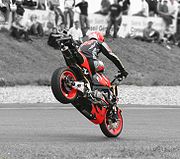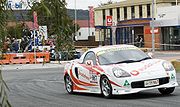
Weight transfer
Encyclopedia



Center of mass
In physics, the center of mass or barycenter of a system is the average location of all of its mass. In the case of a rigid body, the position of the center of mass is fixed in relation to the body...
(CoM) location relative to the wheels because of suspension
Suspension (vehicle)
Suspension is the term given to the system of springs, shock absorbers and linkages that connects a vehicle to its wheels. Suspension systems serve a dual purpose — contributing to the car's roadholding/handling and braking for good active safety and driving pleasure, and keeping vehicle occupants...
compliance or cargo
Cargo
Cargo is goods or produce transported, generally for commercial gain, by ship, aircraft, train, van or truck. In modern times, containers are used in most intermodal long-haul cargo transport.-Marine:...
shifting or sloshing. In the automobile
Automobile
An automobile, autocar, motor car or car is a wheeled motor vehicle used for transporting passengers, which also carries its own engine or motor...
industry, weight transfer customarily refers to the change in load borne by different wheels during acceleration. This is more properly referred to as load transfer, and that is the expression used in the motorcycle
Motorcycle
A motorcycle is a single-track, two-wheeled motor vehicle. Motorcycles vary considerably depending on the task for which they are designed, such as long distance travel, navigating congested urban traffic, cruising, sport and racing, or off-road conditions.Motorcycles are one of the most...
industry, while weight transfer on motorcycles, to a lesser extent on automobiles, and cargo movement on either is due to a change in the CoM location relative to the wheels. This article uses this latter pair of definitions.
Load transfer
In wheeled vehicleVehicle
A vehicle is a device that is designed or used to transport people or cargo. Most often vehicles are manufactured, such as bicycles, cars, motorcycles, trains, ships, boats, and aircraft....
s, load transfer is the measurable change of load
Structural load
Structural loads or actions are forces, deformations or accelerations applied to a structure or its components.Loads cause stresses, deformations and displacements in structures. Assessment of their effects is carried out by the methods of structural analysis...
borne by different wheels during acceleration
Acceleration
In physics, acceleration is the rate of change of velocity with time. In one dimension, acceleration is the rate at which something speeds up or slows down. However, since velocity is a vector, acceleration describes the rate of change of both the magnitude and the direction of velocity. ...
(both longitudinal and lateral). This includes braking
Brake
A brake is a mechanical device which inhibits motion. Its opposite component is a clutch. The rest of this article is dedicated to various types of vehicular brakes....
, and deceleration (which is an acceleration at a negative rate).
No motion of the center of mass relative to the wheels is necessary, and so load transfer may be experienced by vehicles with no suspension at all. Load transfer is a crucial concept in understanding vehicle dynamics
Vehicle dynamics
Vehicle dynamics refers to the dynamics of vehicles, here assumed to be ground vehicles. Vehicle dynamics is a part of engineering primarily based on classical mechanics but it may also involve chemistry, solid state physics, electrical engineering, communications, psychology, control theory,...
. The same is true in bikes, though only longitudinally.
Cause
The major forceForce
In physics, a force is any influence that causes an object to undergo a change in speed, a change in direction, or a change in shape. In other words, a force is that which can cause an object with mass to change its velocity , i.e., to accelerate, or which can cause a flexible object to deform...
s that accelerate a vehicle occur at the tire
Tire
A tire or tyre is a ring-shaped covering that fits around a wheel rim to protect it and enable better vehicle performance by providing a flexible cushion that absorbs shock while keeping the wheel in close contact with the ground...
s' contact patch
Contact patch
Contact patch is the portion of a vehicle's tire that is in actual contact with the road surface. It is most commonly used in the discussion of pneumatic tires, , where the term is strictly used to describe the portion of the tire’s tread that touches the road surface...
es. Since these forces are not directed through the vehicle's CoM, one or more moments
Moment (physics)
In physics, the term moment can refer to many different concepts:*Moment of force is the tendency of a force to twist or rotate an object; see the article torque for details. This is an important, basic concept in engineering and physics. A moment is valued mathematically as the product of the...
are generated whose forces are the tires' traction forces at pavement level, the other one (equal but opposed) is the mass inertia located at the CoM and the moment arm is the distance from pavement surface to CoM. It is these moments that cause variation in the load distributed between the tires. Often this is interpreted by the casual observer
Observation
Observation is either an activity of a living being, such as a human, consisting of receiving knowledge of the outside world through the senses, or the recording of data using scientific instruments. The term may also refer to any data collected during this activity...
as a pitching or rolling motion of the vehicles body. A perfectly rigid vehicle without suspension that would not exhibit pitching or rolling of the body still undergoes load transfer. However, the pitching and rolling of the body of a non-rigid vehicle adds some (small) weight transfer due to the (small) CoM horizontal displacement with respect to the wheel's axis suspension vertical travel and also due to deformation of the tires i.e. contact patch displacement relative to wheel.
Lowering the CoM towards the ground is one method of reducing load transfer. As a result load transfer is reduced in both the longitudinal and lateral directions. Another method of reducing load transfer is by increasing the wheel spacings. Increasing the vehicle's wheelbase (length) reduces longitudinal load transfer while increasing the vehicle's track (width) reduces lateral load transfer. Most high performance automobiles are designed to sit as low as possible and usually have an extended wheelbase and track.
Weight transfer
Weight transfer involves the actual (relatively small) movement of the vehicle CoM relative to the wheel axes due to displacement of the chassisChassis
A chassis consists of an internal framework that supports a man-made object. It is analogous to an animal's skeleton. An example of a chassis is the underpart of a motor vehicle, consisting of the frame with the wheels and machinery.- Vehicles :In the case of vehicles, the term chassis means the...
as the suspension complies, or of cargo or liquids within the vehicle, which results in a redistribution of the total vehicle load between the individual tires.
Center of mass
Weight transfer occurs as the vehicle's CoM shifts during automotive maneuvers. Acceleration causes the sprung massSprung mass
In a vehicle with a suspension, such as an automobile, motorcycle or a tank, sprung mass is the portion of the vehicle's total mass that is supported above the suspension, including in most applications approximately half of the weight of the suspension itself...
to rotate about a geometric axis resulting in relocation of the CoM. Front-back weight transfer is proportional to the change in the longitudinal location of the CoM to the vehicle's wheelbase
Wheelbase
In both road and rail vehicles, the wheelbase is the distance between the centers of the front and rear wheels.- Road :In automobiles, the wheelbase is the horizontal distance between the center of the front wheel and the center of the rear wheel...
, and side-to-side weight transfer (summed over front and rear) is proportional to the ratio of the change in the CoM's lateral location to the vehicle's track
Axle track
The axle track in automobiles and other wheeled vehicles which have two or more wheels on an axle, is the distance between the centreline of two roadwheels on the same axle, each on the other side of the vehicle...
.
Liquids, such as fuel, readily flow within their containers, causing changes in the vehicle's CoM. As fuel is consumed, not only does the position of the CoM change, but the total weight of the vehicle is also reduced.
By way of example, when a vehicle accelerates, a weight transfer toward the rear wheels can occur. An outside observer
Observation
Observation is either an activity of a living being, such as a human, consisting of receiving knowledge of the outside world through the senses, or the recording of data using scientific instruments. The term may also refer to any data collected during this activity...
might witness this as the vehicle visibly leans to the back, or squats. Conversely, under braking, weight transfer toward the front of the car can occur. Under hard braking it might be clearly visible even from inside the vehicle as the nose dives toward the ground (most of this will be due to load transfer). Similarly, during changes in direction (lateral acceleration), weight transfer to the outside of the direction of the turn can occur.
Weight transfer is generally of far less practical importance than load transfer, for cars and SUVs at least. For instance in a 0.9g turn, a car with a track of 1650 mm and a CoM height of 550 mm will see a load transfer of 30% of the vehicle weight, that is the outer wheels will see 30% more load than before, and the inners 30% less. Total available grip will drop by around 3% as a result of this load transfer. At the same time, the CoM of the vehicle will typically move laterally and vertically, relative to the contact patch
Contact patch
Contact patch is the portion of a vehicle's tire that is in actual contact with the road surface. It is most commonly used in the discussion of pneumatic tires, , where the term is strictly used to describe the portion of the tire’s tread that touches the road surface...
by no more than 30 mm, leading to a weight transfer of less than 2%, and a corresponding reduction in grip of 0.01%.
Traction
Load transfer causes the available tractionTraction (engineering)
Traction refers to the maximum frictional force that can be produced between surfaces without slipping.The units of traction are those of force, or if expressed as a coefficient of traction a ratio.-Traction:...
at all four wheels to vary as the car brakes, accelerates, or turns. This bias to one pair of tires doing more "work" than the other pair results in a net loss of total available traction. The net loss can be attributed to the phenomenon known as tire load sensitivity
Tire load sensitivity
Tire load sensitivity describes the behaviour of tires under load. Conventional pneumatic tires do not behave as classical friction theory would suggest...
.
An exception is during positive acceleration when the engine power is driving two or fewer wheels. In this situation where all the tires are not being utilized load transfer can be advantageous. As such, the most powerful cars are almost never front wheel drive, as the acceleration itself causes the front wheels' traction to decrease. This is why sports cars usually have either rear wheel drive or all wheel drive (and in the all wheel drive case, the power tends to be biased toward the rear wheels under normal conditions).

